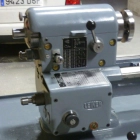The Leinen LZ4SB leadscrew is supported by two bearings. One of them, the corresponding to the adjusting end, has been eroded maybe for a deficient lubrication. This need to be faced again to recover the bearing surface. We plan to do that using a boring head on the milling machine. To support the part in an orthogonal position first an adjusting stud is turned in a lathe. This will guide the bearing when clamped to the table.






